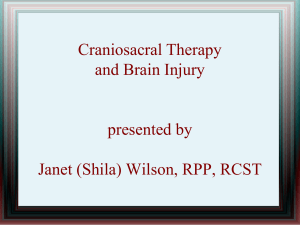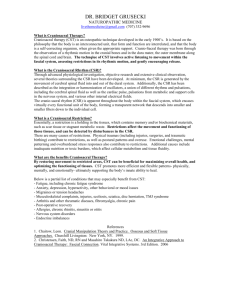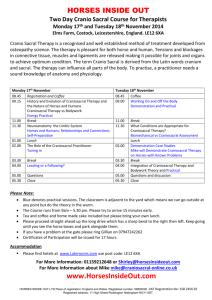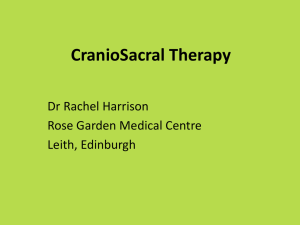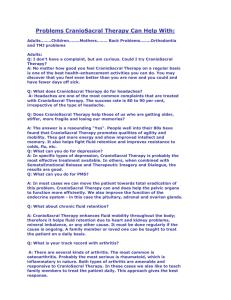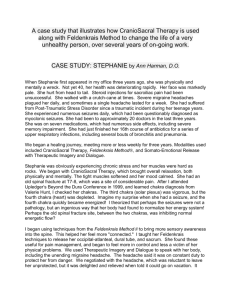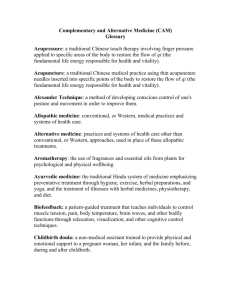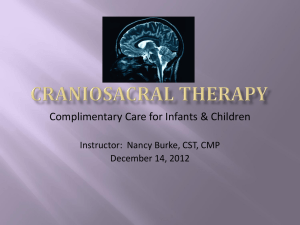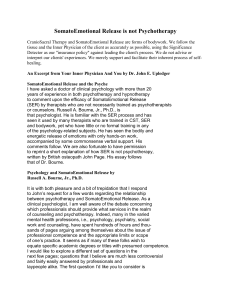Therapeutic Value of CST
advertisement
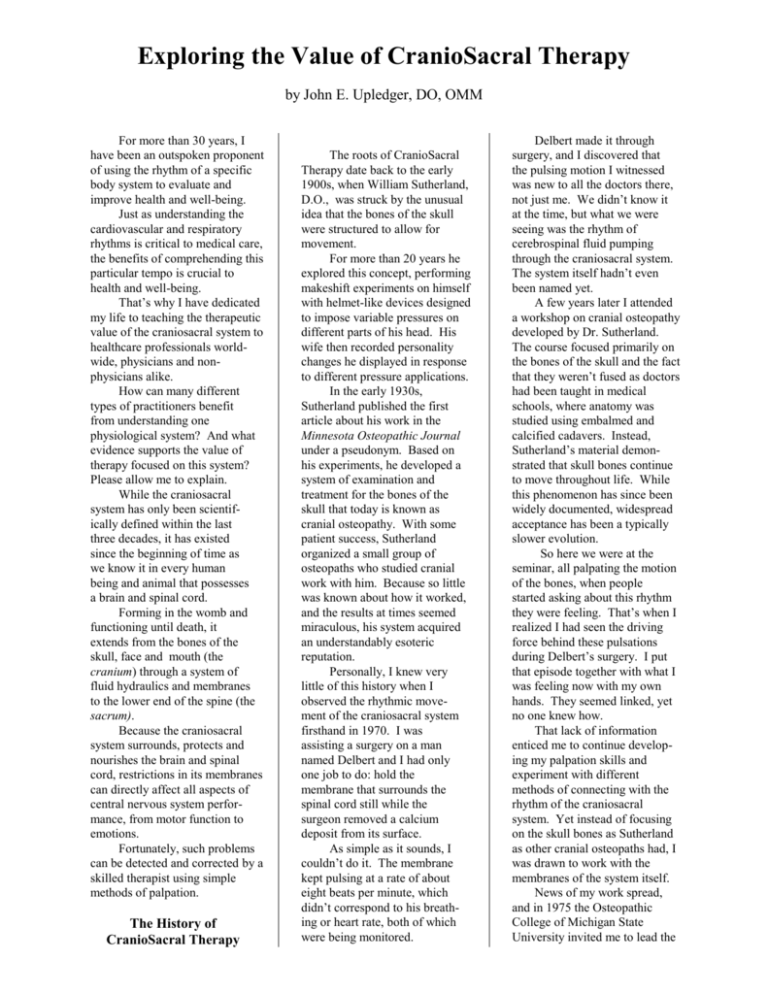
Exploring the Value of CranioSacral Therapy by John E. Upledger, DO, OMM For more than 30 years, I have been an outspoken proponent of using the rhythm of a specific body system to evaluate and improve health and well-being. Just as understanding the cardiovascular and respiratory rhythms is critical to medical care, the benefits of comprehending this particular tempo is crucial to health and well-being. That’s why I have dedicated my life to teaching the therapeutic value of the craniosacral system to healthcare professionals worldwide, physicians and nonphysicians alike. How can many different types of practitioners benefit from understanding one physiological system? And what evidence supports the value of therapy focused on this system? Please allow me to explain. While the craniosacral system has only been scientifically defined within the last three decades, it has existed since the beginning of time as we know it in every human being and animal that possesses a brain and spinal cord. Forming in the womb and functioning until death, it extends from the bones of the skull, face and mouth (the cranium) through a system of fluid hydraulics and membranes to the lower end of the spine (the sacrum). Because the craniosacral system surrounds, protects and nourishes the brain and spinal cord, restrictions in its membranes can directly affect all aspects of central nervous system performance, from motor function to emotions. Fortunately, such problems can be detected and corrected by a skilled therapist using simple methods of palpation. The History of CranioSacral Therapy The roots of CranioSacral Therapy date back to the early 1900s, when William Sutherland, D.O., was struck by the unusual idea that the bones of the skull were structured to allow for movement. For more than 20 years he explored this concept, performing makeshift experiments on himself with helmet-like devices designed to impose variable pressures on different parts of his head. His wife then recorded personality changes he displayed in response to different pressure applications. In the early 1930s, Sutherland published the first article about his work in the Minnesota Osteopathic Journal under a pseudonym. Based on his experiments, he developed a system of examination and treatment for the bones of the skull that today is known as cranial osteopathy. With some patient success, Sutherland organized a small group of osteopaths who studied cranial work with him. Because so little was known about how it worked, and the results at times seemed miraculous, his system acquired an understandably esoteric reputation. Personally, I knew very little of this history when I observed the rhythmic movement of the craniosacral system firsthand in 1970. I was assisting a surgery on a man named Delbert and I had only one job to do: hold the membrane that surrounds the spinal cord still while the surgeon removed a calcium deposit from its surface. As simple as it sounds, I couldn’t do it. The membrane kept pulsing at a rate of about eight beats per minute, which didn’t correspond to his breathing or heart rate, both of which were being monitored. Delbert made it through surgery, and I discovered that the pulsing motion I witnessed was new to all the doctors there, not just me. We didn’t know it at the time, but what we were seeing was the rhythm of cerebrospinal fluid pumping through the craniosacral system. The system itself hadn’t even been named yet. A few years later I attended a workshop on cranial osteopathy developed by Dr. Sutherland. The course focused primarily on the bones of the skull and the fact that they weren’t fused as doctors had been taught in medical schools, where anatomy was studied using embalmed and calcified cadavers. Instead, Sutherland’s material demonstrated that skull bones continue to move throughout life. While this phenomenon has since been widely documented, widespread acceptance has been a typically slower evolution. So here we were at the seminar, all palpating the motion of the bones, when people started asking about this rhythm they were feeling. That’s when I realized I had seen the driving force behind these pulsations during Delbert’s surgery. I put that episode together with what I was feeling now with my own hands. They seemed linked, yet no one knew how. That lack of information enticed me to continue developing my palpation skills and experiment with different methods of connecting with the rhythm of the craniosacral system. Yet instead of focusing on the skull bones as Sutherland as other cranial osteopaths had, I was drawn to work with the membranes of the system itself. News of my work spread, and in 1975 the Osteopathic College of Michigan State University invited me to lead the world’s first task force to study and verify (or debunk) the mobility of cranial sutures and bones. It was an exhilarating time. For the next eight years I led a team of anatomists, physiologists, biophysicists and bioengineers, all testing the potential for performing therapy on the craniosacral system. Together we conducted research, much of it published, that formed the basis for the modality I went on to develop and name CranioSacral Therapy. Yet we continued to take a different approach than the osteopaths who came before us. Again, instead of focusing on the bones of the cranium, we were working with the fluids and membranes of the system within the skull and spinal canal. By blazing this new path, we were finally able to explain the function of the craniosacral system. Then we went on to demonstrate how it could be used to assess and relieve numerous health problems involving the brain and spinal cord. How CranioSacral Therapy Is Performed CranioSacral Therapy is a gentle, non-invasive approach to whole-body health. Generally using about 5 grams of pressure (roughly the weight of a nickel), the practitioner evaluates the craniosacral system by testing for the ease of motion and rhythm of cerebrospinal fluid. Simple manual techniques are then used to release restrictions in fasciae, membranes, and any other tissues that influence the craniosacral system. Experienced clinicians are able to feel the craniosacral motion anywhere on an individual’s fully clothed body. Valuable information can be quickly gained by palpating the rhythm for rate, amplitude, symmetry and quality. Lack of symmetry, for instance, can help localize a pathological problem that may relate to musculoskeletal dysfunctions, inflammatory responses, adhesions, trauma, surgical scars, vascular accidents and many other conditions. As the asymmetry is eliminated and normal sym-metrical craniosacral motion is restored, the problem is often resolved or in the process of being resolved. Consider, too, that fascia is a slightly mobile sheath of connective tissue that runs continuously from head to toe, surrounding every somatic and visceral structure in the body. This fascial system is in constant motion, corresponding to the craniosacral rhythm by both direct connections and common osseous anchorings. With this in mind, it’s easy to see how loss of tissue mobility in one area can be used to trace the location of the disease process that caused the original lack of mobility. Ultimately, CranioSacral Therapy focuses on solving physiological problems at their source by using the individual’s inherent self-corrective mechanisms. It has been shown over and over again, in thousands of cases, that it enhances general health, reduces accumulated stress, strengthens central nervous system function and improves resistance to disease. In today’s critical healthcare arena, I consider that true value. G:\DATA\COMMON\PACKETS\THERVAL7.DOC References: Friedman H.D., Gilliar W.G., Glassman J.H. Osteopathic Manipulative Medicine Approaches to the Primary Respiratory Mechanism. SFIMMS series, 2000. Frymann V.M. A Study of the Rhythmic Motions of the Living Cranium. The Journal of the American Osteopathic Association, May 1971. D. Kostopoulos and G. Keramidas. Changes in Magnitude of Relative Elongation of the Falx Cerebri During the Application of External Forces on the Frontal Bone of an Embalmed Cadaver. Journal of Craniomandibular Practice, Jan. 1992. B. Libin. Occlusal Changes Related to Cranial Bone Mobility. International Journal of Orthodontics, March 1982. Magoun H.I. Osteopathy in the Cranial Field, 3rd ed. Sutherland Cranial Teaching Foundation, 1976. Oleski S.L., Smith G.H., Crow W.T. Radiographic Evidence of Cranial Bone Mobility. The Journal of Craniomandibular Practice, 2002. M. Pick. A Preliminary Single Case MRI Investigation Into Maxillary FrontalParietal Manipulation and Its ShortTerm Effect Upon the Inter-cranial Structures of the Human Brain. Journal of Manipulative and Physio-logic Therapeutics, March/April, 1995. Retzlaff E.W., Mitchell F.W. The Cranium and Its Sutures. Annotated bibliography of more than 250 papers relating to cranial therapy. SpringerVerlag Berlin Heidelberg, 1987. Retzlaff et al. Cranial Bone Mobility. The Journal of the American Osteopathic Association, May 1975. Sutherland, W.G. The Cranial Bowl. Privately published, 1939; reprint, The Osteopathic Cranial Association, 1948. J. Upledger, and J. Vredevoogd. CranioSacral Therapy. Eastland Press, Seattle, 1983. To learn more about CranioSacral Therapy, contact The Upledger Institute. 11211 Prosperity Farms Rd., D-325 Palm Beach Gardens, FL 33410-3487 Clinic: (561) 622-4706 Administration: (561) 622-4334 or (800) 233-5880, priority code R70 upledger@upledger.com www.upledger.com
